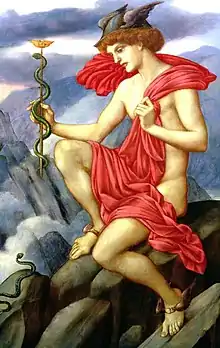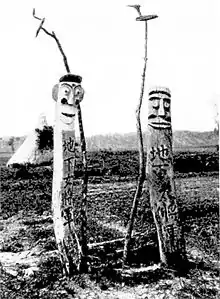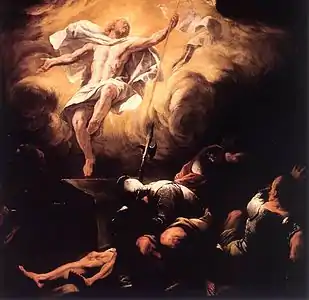
A liminal deity is a god or goddess in mythology who presides over thresholds, gates, or doorways; "a crosser of boundaries".[1] These gods are believed to oversee a state of transition of some kind; such as, the old to the new, the unconscious to the conscious state, the familiar to the unknown.[2]
Types of liminal deities include dying-and-rising deities, various agricultural deities, psychopomps and those who descend into the underworld: crossing the threshold between life and death. Vegetation deities mimic the annual dying and returning of plant life, making them seasonally cyclical liminal deities in contrast to the one-time journey typical of the dying-and-rising myth.
Etymology
The word liminal, first attested to in English in 1884, comes from the Latin word limen, meaning 'threshold'.[3] Liminality is a term given currency in the twentieth century by British cultural anthropologist Victor Turner.[4] It is used to describe a state of transition; such as from the old to the new, from the familiar to the unknown, even from an unconscious to the conscious state.[2]
European
Greek mythology
- Adonis, god of beauty and desire who spent part of his time in the underworld, and part on earth before his tragic death[5]
- Alexiares and Anicetus
- Charon, a psychopomp believed to ferry souls between the worlds of the living and the dead[6]
- Cerberus, a multi-headed dog that guards the gates of the Underworld to prevent the dead from leaving
- Dionysus, who in one myth is torn apart by Titans, but brought back to life
- Enodia, goddess of crossroads
- Hecate, goddess of magic and crossroads
- Heracles
- Hermes, god of roads, merchants, travelers, trade, thievery/thieves, cunning, and animal husbandry; messenger of Zeus and psychopomp[7]
- Iris, goddess of the rainbow and messenger of Hera, could travel to Hades and return
- Persephone, often seen as a goddess of spring and new growth was believed to spend part of her time in the underworld, and part on earth[8]

Roman mythology
- Bacchus, Roman name for Dionysus
- Cardea, goddess of health, thresholds, and door hinges and handles
- Diana, as Diana Trivia she serves as the goddess of three-way crossroads and the underworld; often equated with the Greek Hecate
- Forculus, Lima, and Limentinus, minor deities of thresholds or doorways; see indigitamenta
- Hercules
- Janus, dual-faced god of gates, doors, doorways, beginnings and endings, for whom January is named
- Mercury, messenger god and psychopomp; equivalent to the Greek Hermes and shares several of his functions, such as being a god of commerce, travelers, merchants, and thieves
- Portunus, god of keys, doors, and livestock
- Proserpina, Roman equivalent of Persephone who spent some of her time living in the world of the dead
- Terminus, god who protected boundary markers
Norse mythology
- Gná, Frigg's personal messenger; she rode the horse Hofvarpnir who could travel over both sea and sky
- Heimdall, son of Odin; he keeps watch for invaders and the onset of Ragnarök from his dwelling Himinbjörg, where the burning rainbow bridge Bifröst meets the sky
- Hermóðr, messenger of the Norse gods; he rode to Hel to plead for Baldr's return, ultimately being unsuccessful
- Odin, god of war and death, among other things; he is described as at least once visiting the underworld on Sleipnir, raising a völva to interrogate, and visiting jotunn on three occasions in their domain in order to gather more wisdom
Baltic mythology
- Užsparinė, Lithuanian goddess of land borders
Etruscan mythology
Asian religions
Chinese mythology
- Chen Huang Shen, the gods of walls and moats. Every major city had a City God appointed by the imperial government[10]
- Menshen, the gods of doors
- Chen Wenlong, god of city walls in Fuzhou
Filipino mythology
- Makiubaya: the Ifugao divinities who watch over the gates of the village[11]
- Manduyapit: the Manobo god who ferries departed souls across the red river before going to the afterworld[12]

Korean mythology
- Jangseung, a totem pole traditionally placed at the edges of villages to mark for village boundaries and frighten away demons; also worshipped as tutelary deities[13]
- Munsin, Korean deity of the door. He was considered one of the most powerful of the house gods (Gashin), especially in Jeju Island
Shinto
Vietnamese mythology
- Thành hoàng, god bless and protect villages or a larger area
- Môn thần, the gods of doors
Hinduism
- Agni, god of fire and messenger between gods and mortals, Ganesha seems to have at least partially taken over this role in modern Hinduism
- Ganesha, The god of beginnings.[14] Referred to as the 'Indian Janus' by 18th-century scholar William Jones.[2]
- Pushan, solar deity and psychopomp responsible for marriages, journeys, roads, the feeding of cattle, and overseeing the journey of the dead to the afterlife
- Narasimha, presider over the threshold between interior and exterior
- Matrikas, seven or eight goddess group worshipped at crossroads
Mesopotamian mythology
Phrygian mythology
- Attis, Phrygian vegetation deity; his self-mutilation, death, and resurrection represents the fruits of the earth, which die in winter only to rise again in the spring.
Middle East and Abrahamic religions
Christianity
- Jesus Christ is presented as a crosser of borders.[15][16] The Resurrection of Jesus describes his dying and rising.[17]

African and American religions
African religions
- Osiris, Ancient Egyptian god of the afterlife whose resurrection became associated with the cycles in nature, in particular the sprouting of vegetation and the annual flooding of the Nile River.
- Legba, phallic crossroad spirit and trickster in West African Vodun and Haitian Vodou. He is the bringer of magic, master diviner and speaker of every language who facilitates communication between man and the gods. Legba is also the remover of obstacles and the guardian of the home and crossroads.
Afro-American religions
See also
- Liminal being – Being that cannot be easily placed into a single category of existence
- Gate guardian – Symbolic guardian at a military facility
- Household deity – Deity or spirit associated with the home
Notes
- ↑ "THE GREEK PANTHEON: HERMES". English Mythology Class Notes. Archived from the original on April 2, 2012. Retrieved October 10, 2011.
- 1 2 3 Nadkarni, Vithal. "Ganesha for good start". The Economic Times. Archived from the original on January 12, 2023. Retrieved January 12, 2023.
- ↑ Harper, Douglas. "Online Etymology Dictionary". Archived from the original on October 30, 2011. Retrieved October 10, 2011.
- ↑ Wolf, Allison. “The Liminality of Loki.” Scandinavian-Canadian studies 27 (2020): 106–113.
- ↑ Grimal, Pierre; Kershaw, Stephen (1990). A concise dictionary of classical mythology. Internet Archive. Oxford, England ; Cambridge, Mass., USA : Blackwell. ISBN 978-0-631-16696-2.
- ↑ "A Dictionary of Greek and Roman biography and mythology, Caanthus, Charis, Charon". www.perseus.tufts.edu. Archived from the original on January 3, 2023. Retrieved January 3, 2023.
- ↑ Palmer, Richard E. "The Liminality of Hermes and the Meaning of Hermeneutics". Archived from the original on September 28, 2007. Retrieved October 10, 2011.
- ↑ "A Dictionary of Greek and Roman biography and mythology, Perse'phone". www.perseus.tufts.edu. Archived from the original on March 8, 2021. Retrieved January 3, 2023.
- ↑ "Collections Online | British Museum". August 16, 2022. Archived from the original on August 16, 2022. Retrieved March 7, 2023.
- ↑ "Living in the Chinese Cosmos | Asia for Educators". afe.easia.columbia.edu. Archived from the original on May 13, 2008. Retrieved January 8, 2023.
- ↑ Jocano, F. L. (1969). Philippine Mythology. Quezon City: Capitol Publishing House Inc.
- ↑ Jocano, F. L. (1969). Philippine Mythology. Quezon City: Capitol Publishing House Inc.
- ↑ "Welcome To Korea Now !!!-Society & The Arts". June 27, 2006. Archived from the original on June 27, 2006. Retrieved December 20, 2022.
- ↑ Jenkins, Stephen. "GANESHA". Archived from the original on April 23, 2012. Retrieved October 10, 2011.
- ↑ Barnes, Charles Randall (1912). The People's Bible Encyclopedia: Biographical, Geographical, Historical, and Doctrinal : Illustrated by Nearly Four Hundred Engravings, Maps, Chats, Etc. People's Publication Society. Archived from the original on April 5, 2023. Retrieved January 29, 2023.
- ↑ "Jesus: The Liminal Gate – Two Churches". Archived from the original on November 9, 2021. Retrieved November 9, 2021.
- ↑ "1 Corinthians 15:3–8". bible.oremus.org. Archived from the original on December 9, 2022. Retrieved December 19, 2022.